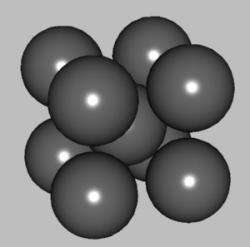Crystal structure prediction made possible

In the past it has been impossible to predict crystal structures with reasonable computing efforts. Even for crystals with relatively few atoms per unit cell the number of possible structures is astronomically large. Now Artem Oganov of the Laboratory of Crystallography at ETH Zurich together with the ETH student Colin Glass have succeeded in developing a new simulation methodology that allows crystal structures to be predicted quickly and reliably.
This new method is implemented in the software developed by the two researchers. The ETH researchers have developed an evolutionary algorithm that finds crystal structures for a given temperature and pressure, without using any experimental information.
The new simulation method generates and evaluates structures. The poorer (i.e. energetically less favourable) structures are discarded and the good ones are used to produce a new generation of structures, which are again evaluated and used for producing further structures. At the end of this process is a crystal structure, that is stable under the given conditions. This method is faster and more reliable than all the existing ones, needs much less computer capacity and can deal with crystals containing more atoms.
Thanks to this new simulation method, Artem Oganov has succeeded in predicting, in a very short time, the crystal structure of lime (calcium carbonate, Ca-CO3) under the extreme conditions of the Earth’s mantle. At elevated pressures and temperatures a structure called aragonite is formed. As the pressure is increased, a new material called post-aragonite, whose structure could not be determined previously, appears. With the new method the ETH researcher was able to resolve this issue. The research results will be published in January 2006 in "Earth and Planetary Science Letters". Crystal structure prediction has great prospects for industrial application: for example, in the design of new pharmaceuticals or superhard materials. Both ETH researchers are continuing to increase the power of the algorithm to enable structures containing hundreds or perhaps even thousands of atoms per unit cell to be predicted in the near future.
Source: ETH Zuerich

















